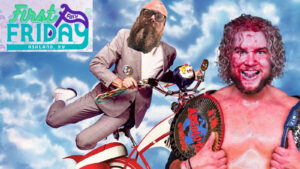Trip Report: ICW No Holds Barred Vol. 69
- The Death Panel — September 2025’s Best & Worst in Deathmatch Wrestling - October 6, 2025
- The Death Panel — August 2025’s Interesting Deathmatches - September 10, 2025
- The Death Panel — July 2025’s Interesting Deathmatches - August 12, 2025
In the crowd, there is a young man with skin the color of skim milk, a beard like Amish Roadkill, a Beatles mop-top haircut, drop-crotch sweats, and Crocs. Another young man is yipped-up in a lucha mask and designer flat-brim, waving a camcorder in his friends’ faces and screaming at them to show their excitement. The vast majority of fans attending ICW NHB 69 are in black hoodies and hardcore punk patches, sporting tattoos on their necks and their fingers, as opposed to the type of wrestling fan who owns as many replica title belts as they do pairs of AND 1 basketball shorts. During a sit-down strike swap between Tank and Little Mean Kathleen, Tank slaps Kathleen. At the bar, a woman’s voice cries out, cutting through any other noise in the venue: “THAT WAS JUST A LOVE TAP! FUCKING! HIT! HER!” Some professional wrestling claims to be “for the sickos,” and some professional wrestling actually is.

ICW NHB 69 is in Sonia, a music venue that used to be called T.T. the Bear’s Place. (I remember seeing the Moldy Peaches there in high school, and then Liars in my freshman year of college, among other fond memories.) There are only forty or fifty seats, all set up on the stage; the wrestlers have to walk through them to get to the ring. The other three sides of the ring are standing room only. Being in the crowd means constantly moving: to create space for dives, make room for a cameraperson or some wrestlers doing a walk-and-brawl, let someone scoot past you on their way to or from the bar, whatever. Unless you’re seated on the stage or in a lucky spot right up against the ring, you have to keep your head on just a bit of a swivel. It’s an entirely different feeling from sitting in an arena. Things never get a chance to settle into a lull. There are no conspicuous silences. The nervous energy is always there, even between the matches, when the ring crew is sweeping away debris.
When the show starts, it feels like it’s meeting local New England indie wrestling halfway. The chains are there, but so is Rich Palladino. (He was in his tuxedo, ring-announcing Chaotic Wrestling shows starring Edward G. Xtasy and “Latin Fury” Luis Ortiz at the dog track in Revere, back when I was seeing the Moldy Peaches at T.T. the Bear’s Place.) Recent northeast fixtures Waves and Curls (Jaylen Brandyn and Traevon Jordan) square off against ICW NHB regulars the Pillars (Tommy Vendetta and Malcom Monroe III). The Pillars remind me of the Young Bucks in a way that I’m not sure I can articulate. They always seem like they’re on the verge of looking straight into the camera and winking, if that makes sense. I couldn’t tell you if this is a good or a bad thing. Both teams run through all the stuff you do to get a crowd making noise without burning them out too early. There’s a dance contest, a silly argument, a confetti cannon, a dive train. The next match is between Tank, a Southern deathmatch mainstay built as solidly and as thickly as poured concrete, and Little Mean Kathleen, a local indie darling who gets by on being small, loud, and constantly making this face where it looks like she’s not sure if she’s taking a shit or not. They get silly and disappoint that poor woman at the bar who wanted Tank to Butterbean-punch LMK in the jaw or something.
The shift away from New England indie-dom and towards complete No Holds Barred comes in the third match. JT Dunn comes out and is lustily jeered. Dunn is a poster child of the local indies, and pitting him against ICW NHB owner Danny Demanto is a symbolic match. Consider that this is a match where the Massachusetts crowd boos the announcement of Dunn as being from Providence, and then turns around and cheers Demanto’s hometown of Queens. Even if he has the crippling lifelong problem of being from New York, Demanto still represents the hardcore wrestling that the crowd bought tickets to see. Dunn, on the other hand, represents (in his own words) “headlocks, and hip tosses, and arm drags, and arm drags, and arm drags…” This is the closest thing on the show to a battle of good versus evil, where “good” is found in thumbtacks and Psycho Driver Fuck Your Lives and blood smeared on broken bits of doors, and “evil” is anything trying to pull away from that bubble and back towards “normal” and “respectable” pro wrestling. During the match, Demanto bleeds; Dunn doesn’t. Hardcore wrestling wins, and the show frees itself from imaginary shackles. Now things can really get nasty.
Nathan Mowery and Alex Stretch do the types of things that would get a respectable TV promotion to lose their action figure deal. One of Mowery’s signature spots is to brandish a hacksaw (“Where I come from… the SAW is the LAW!”) and then grind it across his opponent’s head like he’s bowing a particularly uptempo cello piece. He and Stretch face off on their knees, hold gusset plates against one another’s cheeks and then hammer them in. It takes a couple tries on each to make them really stick. Both men feed on the howls of the crowd, and in turn make the crowd howl for more. At points, I can’t even cheer, just laugh, in the same way that you might laugh if you see your friend slip and land nuts-first on a railing. The next match after this has Matt Tremont (whose forehead reminds me of the typewriter from Cronenberg’s film version of Naked Lunch), Kaplan, and SLADE all whacking away at each other’s heads with plastic bats wrapped in thumbtacks. The only way that this is all that different from some kind of Three Stooges slapstick routine is that it goes on much longer, and that Curly never wore a crimson mask. Slade spends most of the match with a small grid of tacks stuck square into the top of his head. Just like the Mowery vs. Stretch match, all three men indulge some inner beast, and even if some of the wrestling maneuvers (such as they are) aren’t “successfully” delivered, they still look like what they are: grown men making each other bleed, picking each other up and throwing each other around. It feels uncontrolled and, in some primal way, playful and joyous. I don’t laugh at the pain because it’s funny, but I do laugh with delight all the same.
The main event is a tag team match pitting Bobby Beverly and surprise partner Krule against the Bev’s old running buddies in the 44OH! stable, Atticus and Otis Cogar. Atticus strikes me as the closest thing wrestling has right now to a figure like Raven was in the 1990s. He’s someone who seems like he’d rather take a big swing (knowing that it might whiff) than go for a safer approach with a lesser potential reward. He’s mouthy and flashy and does things like brand his t-shirts with a pig’s head and the number to the National Suicide Hotline. Otis is a man who missed his calling as the antagonist in prison movies. He’s bald, stocky, heavy brow and beady eyes, with an expression like he’s constantly seeking out the weakest person in the room. In a different kind of movie, you could see Atticus as a motor-mouthed crank dealer and Otis as leg-breaking heavy, and you’d probably be cheering for Walter White or whoever to finally just shoot them. Krule is a monster in the tradition of pure pro wrestling theatricality, with his mask, his bleachy-bright contacts, and his towering stature. Next to a character like Krule, Beverly comes across as the common man, bleeding and suffering, struggling through a fight in a way that Krule won’t (and shouldn’t) ever show. The four faces of wrestling, all in one bout: the provocateur, the bully, the enigma, and the Bev.
There’s a point in the night, probably while I’m watching Kaplan bleed buckets as Tremont and SLADE take turns teeing off on him, where I start to wonder why people do this stuff. Why subject yourself to so much pain? Why bleed for money? Usually, you only have to do a rite of passage once, and once you’ve proven your bravery, well… you’ve passed. Things like Toughman contests have an edge of real competition to them, versus the fixed results of pro wrestling. It’s when standing in the middle of a crowd like the one at ICW NHB 69 that it clicks why these guys do it: because we tell them that we love them for it. We scream for them. We fist-bump them as we see them drifting towards the bar. We buy their shirts, their autographs, or in Kaplan’s case, their homemade beef jerky. Stepping into the chains isn’t so bad. People do so much worse for love.



